Black Gate Goes to the Summer Movies: Brave
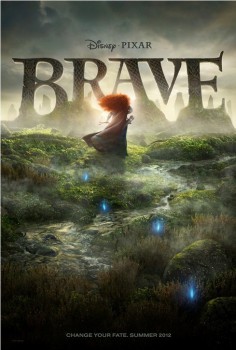 Who would think at the start of the summer that Brave was concealing more of its plot and themes than Prometheus? Strange days, my friends.
Who would think at the start of the summer that Brave was concealing more of its plot and themes than Prometheus? Strange days, my friends.
Ninety percent of the trailer for Brave comes from the first twenty-five percent of the movie. And to continue with percentages, fifty percent of Brave is a great film, and worthy to stand beside earlier Pixar classics. But except for a few flashes in the trailer, Disney and Pixar have revealed nothing of this later-running time greatness to you. The marketing department and directors Andrew Jones and Brenda Chapman have even specifically asked reviewers to hide what the center of the movie is about.
This is not a case of concealing a twist ending or a mid-movie shocker, but disguising the core of the film. Imagine a trailer for Pinocchio that never reveals that the puppet comes to life: it’s the story of a sad woodcarver and his pets who meet a blue fairy, and later on an enormous whale may peep into the plot. Or a trailer for King Kong that not only never shows the eighteen-foot gorilla, it never hints that there might be a giant monster of any sort in the film. According to this trailer, King Kong looks like the tale of a young woman who goes on a voyage with a film crew, possibly to find (dinosaur- and gorilla-free) adventure and romance away from dreary Depression Era New York.
Brave is the story of Merida (voice of Kelly Macdonald), a Scottish princess who hates that her parents King Fergus (Billy Connolly) and Queen Elinor (Emma Thompson) are trying to marry her off to a dullard in a political alliance when all she wants is her freedom — like any good Disney Princess™ — and the chance to choose her own destiny. While exploring, Merida discovers magic in the forest after following a trail of Will-‘o-the-Wisps. The rest of the story follows the standard princess adventure: she’ll go out on her own, fight some monsters, discover a handsome and roguish fellow who likes her for who she is, and her parents will finally let their daughter be herself and marry the man she loves.
Except, after the words “The rest of the story…” that is not actually the plot of the film. At all. It isn’t the main character conflict or the thematic center. I made it up. Don’t expect some sort of Sixth Sense twist, such as Merida discovering she’s actually trapped inside a giant video game or Mars invading medieval Scotland, but the story does pick a different and better way than the second half of my Disney-influenced outline. A very average opening gives way to a film that has much more to say, in the vaunted Pixar fashion.
I will reveal at least this: expect a helluva a lot more “bear” than you’ve seen in the trailers. This is a good thing. I like Big Bears and I cannot lie!
Pixar is at a difficult creative crossroads in its existence. Financially, the studio remains king, but this is more because of merchandizing. Cars 2, the poorest film in Pixar’s canon, was produced purely to increase the toy empire the first movie established. (As of last year, over eight billion dollars of Cars merchandize has been sold. My four-year-old nephew has contributed significantly.) Cars 2 was an underwhelmer at the box-office, failing to crack $200 million domestically as all other Pixar’s films have, but it didn’t matter: the release doubled the speed the toys flew off the warehouse shelves.
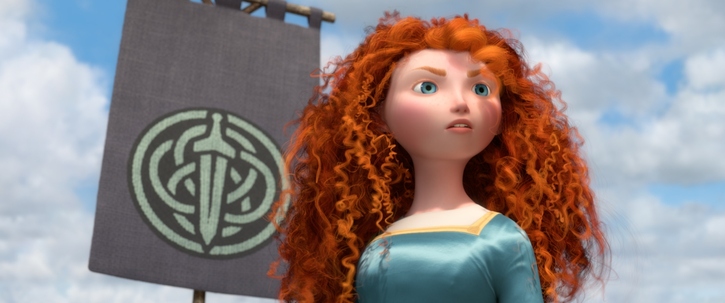 For adult Pixar fans in love with the humanity, humor, and pure storytelling of classics like The Incredibles, WALL·E, and Up, the second Cars movie felt like a Benedict Arnold flick. It wasn’t even a case of Cars 2 being “not great for Pixar, but still good.” No, Cars 2 is awful. Seriously awful. I watched it in disbelief that the filmmakers so famous for their adherence to excellent dramatics above all else could so cavalierly toss out their “22 Rules of Storytelling” to sell plastic molded crap. Pixar needed to prove to its older fans it was interested in more than Happy Meal toys with its next film.
For adult Pixar fans in love with the humanity, humor, and pure storytelling of classics like The Incredibles, WALL·E, and Up, the second Cars movie felt like a Benedict Arnold flick. It wasn’t even a case of Cars 2 being “not great for Pixar, but still good.” No, Cars 2 is awful. Seriously awful. I watched it in disbelief that the filmmakers so famous for their adherence to excellent dramatics above all else could so cavalierly toss out their “22 Rules of Storytelling” to sell plastic molded crap. Pixar needed to prove to its older fans it was interested in more than Happy Meal toys with its next film.
Brave shows this, since it is one of the least merchandizing-friendly films to emerged from the studio. Even with a female heroine for the first time, Brave is not chasing after the Disney Princess market. One of the movie’s finest surprises when the true plot begins is how much of the “princess” formula gets jettisoned for a different kind of character tale. Merida’s wish for freedom does not vanish, but her arc gets directed a new way.
But Brave still doesn’t mark a complete return to the glories of something like Up, which achieves sublimity in the first ten minutes and carries the audience effortlessly from that point. I could write a whole post about the effectiveness of Up’s beginning as it relates to the rest of the film. Brave is more of an ambling and simple-minded story when it begins, and even when the actual story unveils itself, it never reaches the intimacy and intricacy of the company’s classics. Brave subverts expectations, but it also has such a shaky start that you wonder if anyone involved remembered the amazing power of how Up used its opening to propel the whole film toward the stratosphere.
So let’s look at Rule #7 of Pixar’s 22 Rules of Storytelling: “Come up with your ending before you figure out your middle. Seriously. Endings are hard. Get yours working up front.”
Excellent advice. But Pixar forgot to put in Rule #7.5: “Also, come up with the best and most fine-tuned opening before you figure out your middle. Seriously. Beginnings are hard. Get yours working, and keep working at it, until you know you have the audience up front.”
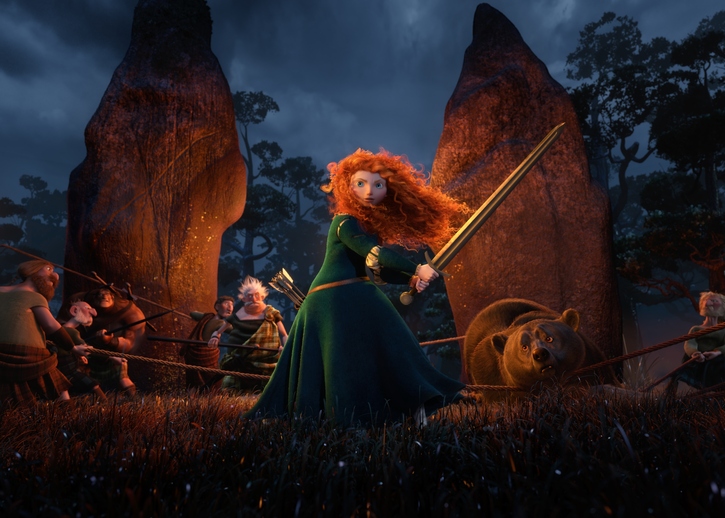 I think Pixar needs to rethink Rule #7, because Up contained numerous failed endings (watch the bonus features on the DVD/Blu-ray to see what they are) that the filmmakers ditched until they hit upon right one. But the amazing beginning was what finally guided them to the excellent ending that did work. They realized who the story should be about, what its theme was, and the endings that didn’t click dropped out until they found the one that matched the opening.
I think Pixar needs to rethink Rule #7, because Up contained numerous failed endings (watch the bonus features on the DVD/Blu-ray to see what they are) that the filmmakers ditched until they hit upon right one. But the amazing beginning was what finally guided them to the excellent ending that did work. They realized who the story should be about, what its theme was, and the endings that didn’t click dropped out until they found the one that matched the opening.
Brave has a strong ending. It has a strong half of the middle. But it doesn’t feel as if anyone was paying much attention to the beginning and the first half of the middle.
Brave, Act I is too much of an imitation of the familiar model, not only of the Disney Princess but of the general fairy-tale setting. I understand the set-up for subversion of a formula, but the film still needs to feel vibrant in these segments, not simply “fine.” It feels unfinished, and that is bizarre for Pixar. Not unfinished in its visuals, but unfinished in terms of story and writing. The sharp polish is off the dialogue. The special quirks of the supporting characters are absent. The humor comes pitched at the easy level. The main scene, an archery tournament with a “split arrow” finale, arrives straight from the 1938 The Adventures of Robin Hood without any variance except a female lead. (Oh, the 1973 Disney Robin Hood did the same scene.) It’s almost as if a first draft went before the computer animators. All of it seems dry and a touch uninspired, and on my first viewing I wriggled in my seat wondering if Pixar had botched it again.
Even when the real story begins — which, I need to emphasize, isn’t a massive shock twist, and has happened in animated Disney films before — Brave still has trouble finding its momentum. It’s no surprise that the discovery of its heart comes when the real character relationship of the film begins to cement, and the dissolution of the sense of order within the Scottish kingdom starts to veer toward King Lear chaos. Then the movie gets its hoofs underneath it and really starts to gallop….
There is much wonderful about Brave, Act II. The action and character drama of the second half deliver what the film needed all along: genuine heart. Brave does deliver an effective emotional finale (big monsters hitting each other brings tears to my eyes, if maybe not to you) even though it won’t come as a shock and it won’t top some of the Pixar classic moments. It isn’t the waterworks I got for from Up — egad, that film tears me up — and WALL·E — which I’ve come to believe is Pixar’s finest film — but it works, and it caps off the film with what seems, in retrospect, the only way it could’ve ended. (Well, there was this spot where the movie might have gone completely Macbeth, and I would have loved to see that, but such was not to be unless Disney was okay with a “R” rating. Heh-heh. Well, tomorrow, and tomorrow, and tomorrow… we can hope.)
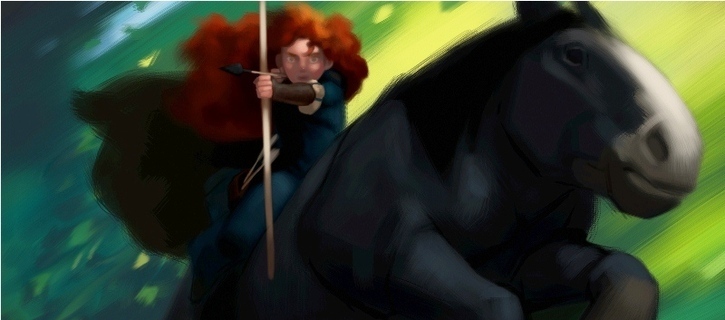 Merida is a character who balances between excellence and ordinariness. She is best when she moves away from the “feisty heroine” mold and matures; by the end she is a wonderful creation, a woman who might become Jirel of Joiry. This is an example of character change that comes from breaking the stereotype of character change. Queen Elinor, Merida’s mother and foil for most of the movie, is also a figure of sometimes breathtaking depth and strength. To have two such strong female leads in a film, involved in a story that isn’t about a male-female romance, is refreshing — even if it takes half the movie for this to break out on the screen.
Merida is a character who balances between excellence and ordinariness. She is best when she moves away from the “feisty heroine” mold and matures; by the end she is a wonderful creation, a woman who might become Jirel of Joiry. This is an example of character change that comes from breaking the stereotype of character change. Queen Elinor, Merida’s mother and foil for most of the movie, is also a figure of sometimes breathtaking depth and strength. To have two such strong female leads in a film, involved in a story that isn’t about a male-female romance, is refreshing — even if it takes half the movie for this to break out on the screen.
Brave unfortunately doesn’t stack up the best supporting cast, which is an odd weakness for Pixar. This is the reverse of Cars, which failed with its leads but contained a truckload of oddballs to distract viewers. I’d rather err on the side of Brave with a better story and protagonists, but the lax supporting characters are one of its problems. Only Merida’s triplet brothers and the demon bear Mor’du (awe-some! by the way) break through, and their heights are both reserved for the latter part of the movie. The brothers’ role in the story makes a dramatic shift with the rest of tale midway; they are ordinary bits of humor before then.
The rest of the characters are, unfortunately, a lot a standard Scottish gags I’ve seen done numerous times before. Billy Connolly is a great Billy Connolly, but he’s playing the same big lug figure I expect. I wish the film pulled more humor from the suitor for Merida’s hand whose Scottish accent is purposely incomprehensible, even to the other Scotsman, but he only gets two lines. If a joke works, at least milk it for four lines.
Visually, Pixar shows no signs of losing their inventive momentum or will to experiment. Brave is the least colorful film they’ve made, but that’s not criticism. The subdued naturalism of the palette is the best version of the “real” world the magicians of Pixar have yet realized. Color bursts 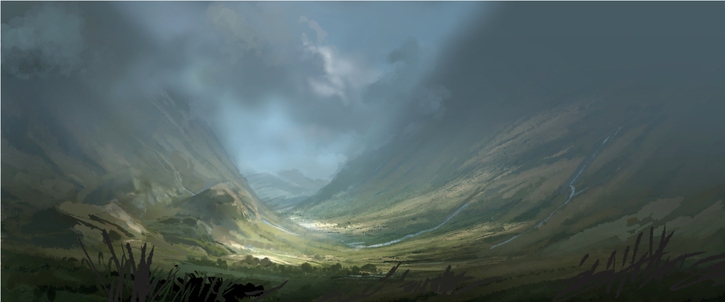 in for brief effect, such as the hypnotic blue of the Will-o’-the-Wisps that lure Merida to the forces of magic, and the greens and grays of the screen make Merida’s bouncy red locks, already a marvel of animation, pop out even more. There are fewer shots here of intricate, screen-cramming action such as seen in WALL·E, but the depth of the Highlands is powerful even without 3D. (I watched the film in 2D; I think 3D damaged my first viewing of Up, so I avoid 3D on all Pixar films. They have depth enough without such artifice.)
in for brief effect, such as the hypnotic blue of the Will-o’-the-Wisps that lure Merida to the forces of magic, and the greens and grays of the screen make Merida’s bouncy red locks, already a marvel of animation, pop out even more. There are fewer shots here of intricate, screen-cramming action such as seen in WALL·E, but the depth of the Highlands is powerful even without 3D. (I watched the film in 2D; I think 3D damaged my first viewing of Up, so I avoid 3D on all Pixar films. They have depth enough without such artifice.)
I dearly wish I could say that Pixar is back in full form with Brave. They’ve gotten halfway there, but I find it a shame that the fantasy setting didn’t bring a return to Incredibles greatness, capturing that film’s level of character complexity and layered thematics. The Incredibles is the movie that Brave is the most akin to, because it also wants to play with the expectations of an established visual storytelling mode: the comic book for The Incredibles, the Disney fairy-tale for Brave. As a slant on Disney’s fairy-tale classics, Brave provides a wonderful inversion. As an example of the company’s customary energy, plotting, characterization, and humor, it breaks evenly in the middle. There’s a missing great first half of Brave I would love to see, and I wonder if the filmmakers in the haste to get to the turnaround point moved too sloppily through the early parts. Just because we’ve seen such a set-up before doesn’t mean this part shouldn’t be told the best that it could. Compared to the second half, the first half of Brave is “settling.”
Co-director Mark Andrews even seems to have admitted as much. When discussing the unusual marketing strategy, he remarked:
All of the twists and turns that support that story — that’s the present to the audience. If you’re coming to see this film basically because you know there’s going to be action and adventure in it and it’s about this young woman who is going to find herself and there’s a dilemma with her parent, you’re already invested in that character. Everything else is gravy. We wanted that experience to be a gift to the audience.
In the context of talking about the marketing, Andrews means the story’s premise, the change toward the main plot, should be a gift to the audience. I agree. But I also think the whole film should be a gift to the audience. Andrews’s statement assumes I have an automatic investment in the characters and their conflicts if I come out to see the movie. No, not necessarily. In fact, no, not at all. I may imagine an investment from trailers, but that is really anticipation, which is not connected to the actual storytelling of the contained work. The moment the lights go down and the film’s first frames start, the story has to begin the real work of narrative that goes beyond advertising.
And this is where I begin to grasp my issues with the first part of Brave. I’ll emphasize again that it isn’t a terrible first half, just an average one and something below Pixar’s pre-Cars standard. But it does seem as if the directors, writers, and animators took the audience’s liking for the characters and their situation as a given. A great movie, like a great novel or short story or play, should starting giving as a gift from its very beginning. And Brave does not do that. So I can only give the film my half recommendation, applaud Pixar for the fine second half, and tell them: do better next time. Which is Rule #8 on Pixar’s 22 Rules of Storytelling.
But, at the end of the day… I did enjoy Brave. I’m actually giving it a “B+” on my Summer Scorecard, making it my second favorite film of the season so far after The Avengers. (Up against Battleship and Dark Shadows, admittedly…) The company can do better, but they’ve done a whole lot worse. It’s a quality piece of fantasy filmmaking, and a visual feast to behold. Please, please, take your children to see this instead of Madagascar 3. This review reflects my belief that Brave deserves a higher level of scrutiny and criticism because the company has set their own bar so very, very high.
Huh, you know… I started thinking about a CGI Macbeth, and I realized that a computer-animated adaptation of Shakespeare — a genuine adaptation, using his language — might be wonderful. A Midsummer Night’s Dream especially. Or The Tempest. I doubt anyone will risk such mature fare with the medium. A pity.
My Summer Movie Scorecard
Brave . . . . . . . . . . B+
Prometheus . . . . . . . . . . B
Snow White and the Huntsman . . . . . . . . . . B
Men in Black 3 . . . . . . . . . . C+
Battleship . . . . . . . . . . D
Dark Shadows . . . . . . . . . . C-
The Avengers . . . . . . . . . A
Next week: Two weeks until The Amazing Spider-Man. I’m going back to Mars between then.
Ryan Harvey is a veteran blogger for Black Gate and an award-winning science-fiction and fantasy author. He received the Writers of the Future Award in 2011 for his short story “An Acolyte of Black Spires,” and has two stories forthcoming in Black Gate, as well as a currently available e-book in the same setting. He also knows Godzilla personally. You can keep up with him at his website, www.RyanHarveyWriter.com, and follow him on Twitter.
[…] #4: Brave (June 22nd) […]
[…] Summer Movie Scorecard The Amazing Spider-Man . . . . . . . . . . C Brave . . . . . . . . . . B+ Prometheus . . . . . . . . . . B Snow White and the Huntsman . . . . . . . . […]
[…] Black-Gate-goes-to-the-summer-movies-brave […]
[…] . . . C- The Dark Knight Rises . . . . . . . . . . A- The Amazing Spider-Man . . . . . . . . . . C Brave . . . . . . . . . . B+ Prometheus . . . . . . . . . . B Snow White and the Huntsman . . . . . . . . […]
[…] . . . C- The Dark Knight Rises . . . . . . . . . . A- The Amazing Spider-Man . . . . . . . . . . C Brave . . . . . . . . . . B+ Prometheus . . . . . . . . . . B Snow White and the Huntsman . . . . . . . . […]
[…] . . . C- The Dark Knight Rises . . . . . . . . . . A- The Amazing Spider-Man . . . . . . . . . . C Brave . . . . . . . . . . B+ Prometheus . . . . . . . . . . B Snow White and the Huntsman . . . . . . . . […]